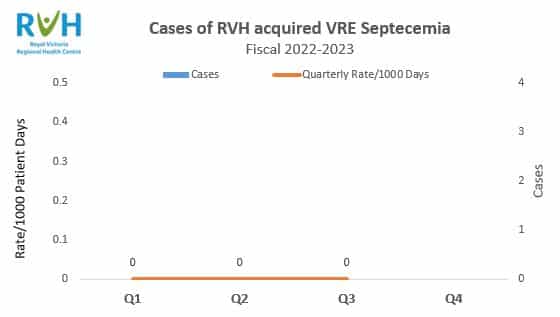The method for calculating the VRE bacteremia infection rate for the reporting period
(quarterly) is:
Number of nosocomial patients with laboratory identification of VRE bacteremia x 1000
Total number of patient days.

| Q1 | Q2 | Q3 | Q4 | |
| VRE Cases | 0 | 0 | 0 | |
| Quarterly Rate/1000 Days | 0 | 0 | 0 |
What is VRE (Vancomycin Resistant Enterococcus)?
Enterococci are germs that live in the gastrointestinal tract (bowels) of most people and generally do not cause harm (this is termed ‘colonization’). Vancomycin-resistant enterococci (VRE) are strains of enterococci that are resistant to the antibiotic vancomycin. If a person has an infection caused by VRE, such as a urinary tract infection or blood infection, it may be more difficult to treat.
Hospital Associated/Nosocomial VRE: The organism is considered hospital associated/nosocomial if we detect the presence of VRE or MRSA 72 hours after admission and it is not likely that the patient has been exposed to either bacteria before they were admitted to us.
It is important to monitor for these types of infections because we do not want them to spread between patients or from patient to visitor. We call this process of monitoring surveillance.
How is Surveillance Done?
We check patients for VRE by using sterile cotton swabs and rubbing them on different places on their bodies. If a patient is at high risk for one of these infections, we do the swab testing when these patients are admitted and at other times during his or her hospital stay. These swabs are sent for testing. We call this procedure, screening. If one of these bacteria is found, we put control measures in place to prevent transmission to other patients. If a patient has diarrhea a stool sample will be sent to detect the toxin that is formed from the C. difficile bacteria.
What does it mean if a patient has one of these bacteria?
The presence of bacteria such as VRE does not necessarily mean that anyone has an infection. It does mean that a patient is more at risk to get an infection, especially if that patient already has a compromised immune system.
How is VRE spread?
VRE is spread from one person to another by contact, usually on the hands of caregivers. VRE can be present on the caregiver’s hands, either from touching soiled articles belonging to an infected person. VRE survives on hands and can survive for weeks on inanimate objects such as toilet seats, taps, door handles, bedrails, furniture and bedpans. VRE is easy to kill with the proper use of disinfectants and good hand hygiene.
What Special Precautions are Required for VRE in the Health Centre?
Precautions include:
• Single room accommodation (the door can remain open)
• A long-sleeved gown and gloves must be worn by everyone who cares for you
• A sign may be placed on your door to remind others who enter your room about the special precautions
• The room and the equipment used in the room will be cleaned and disinfected regularly
• Everyone who leaves your room must clean their hands well
• You must wash your hands before you leave your room
• Your activities outside your room may be limited
What about Family and Visitors?
Your family and visitors should not assist other patients with their personal care as this may cause the germ to spread. They may be required to wear a long-sleeved gown and gloves while in your room. Before leaving your room, visitors must remove the gloves and gown and dispose of them in the garbage container and linen hamper located in your room. Then they must clean their hands.
Good Hand Hygiene Practices
Remind all staff and visitors to practice good hand hygiene before and after they touch you. Ask your nurse or doctor to demonstrate proper hand hygiene techniques (15 seconds of soap and running water OR waterless alcohol hand rub until hands are dry).
You need to clean your hands:
• After using the bathroom
• After blowing your nose
• Before eating and drinking
• Before and after you touch your dressing or wounds
• When your hands are visibly dirty (soiled)
• Before you leave your room
What Will Happen at Home?
If you have VRE at the time of discharge from hospital, there is a small chance of spreading the germ to your family. We recommend you practice the following:
• Everyone who might help you with your personal hygiene or with going to the toilet should wash their hands after contact with you.
• Wash your hands before you make any food and before you eat. This practice should be followed by everyone in the household.
• Wash your hands well after using the toilet. If you share a bathroom, make sure others using that bathroom wash their hands well afterwards.
• If you share a bathroom at home, clean the toilet and sink at least weekly with a germicidal cleanser.
• Clothing may be laundered in the same manner as the rest of the household laundry.
• No special cleaning of furniture or items (e.g. dishes) in the home is required.
• Always tell your physician, paramedics, nurses or other care providers that you have VRE. This helps prevent spread to others.
For more information, please speak to your Health Care Provider.

